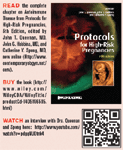Snapshot
In this protocol, Dr. Lockwood reviews the pathophysiology, diagnosis, and treatment of autoimmune disease in pregnancy. Included are guidelines for management of systemic lupus erythematous (SLE), rheumatoid arthritis (RA), scleroderma, and rarer autoimmune disorders.
AUTHOR: CHARLES J. LOCKWOOD, MD, MHCM, DEAN OF THE COLLEGE OF MEDICINE AND VICE PRESIDENT FOR HEALTH SCIENCES, THE OHIO STATE UNIVERSITY, COLUMBUS, OH

As the author notes, because of their predilection for women and common occurrence in the reproductive age, autoimmune diseases are a relatively common complication of pregnancy. Understanding the effect of pregnancy on the disease and the effect of the disease on pregnancy is a crucial aspect of managing affected pregnant patients.
• SLE is triggered by an abnormal humoral antibody response that causes the production of antibodies that cross-react with a variety of tissues in genetically susceptible individuals. The antibodies form non-specific antibody complexes, which cause inflammation, leading to related conditions such as antiphospholipid antibody syndrome (APAS). One theory about SLE with direct implication in pregnancy outcome is activation of complement by APAS, causing vascular inflammation and changes within the fetus and placenta.
• Lupus flares occur in 50% of pregnant patients and are more common in the first trimester. Half of SLE patients have clinical evidence of glomerulonephritis.
• Twenty-five percent of SLE patients have APAS, which causes second- and third-trimester fetal death, intrauterine growth restriction (IUGR), preeclampsia, and maternal thromboembolic phenomenon. Risk of recurrent pregnancy loss is 70% in patients whose SLE and APAS are untreated. Twenty-five percent of patients with SLE have anti-SSA (Ro) antibodies, which are associated with an HLA-DR3 haplotype and linked to congenital heart block in 1% to 2% of cases and neonatal rash in 10% to 20% of infants.
• Congenital SLE is far more common in female neonates (14:1 for cutaneous and systemic involvement and 2:1 for isolated congenital heart block [CHB]). Lesions generally appear within 6 weeks of birth and persist for 1 year.
• SLE diagnosis is established when four or more of the American College of Rheumatology criteria are present: 1) malar rash; 2) discoid rash; 3) photosensitivity; 4) oral ulcers; 5) non-erosive arthritis; 6) pleuritic or pericarditis; 7) renal disease; 8) neurological abnormalities; 9) hematological abnormalities; 10) laboratory findings; 11) positive antinuclear antibody test.
• Patients with SLE should have a complete blood count (CBC), 24-hour urine collection, and other laboratory studies and indices of disease activity performed at the first prenatal visit. First-trimester ultrasonography and aneuploidy screening are recommended. Fetal echocardiography should be performed at 18 weeks and then monthly by an experienced physician in patients with SLE at risk for neonatal lupus or CHB on the basis of anti-SSA antibodies.
• Presence of lupus anticoagulant or moderate- to high-level anticardiolipin antibodies in a pregnant patient with SLE is an indication for treatment with low-dose aspirin and either prophylactic or therapeutic heparin or low-molecular- weight heparin.
• In patients with SLE whose disease is uncomplicated and not worsening, delivery can be delayed until 40 weeks, provided there is no superimposed preeclampsia, fetal growth is normal, and twice-weekly fetal testing initiated at 36 weeks is reassuring. Protocols for delivery in the presence of deteriorating maternal or fetal health vary depending on the fetus's gestational age.
• RA is the most common autoimmune disease in women of childbearing age, with a prevalence of 1 per 2,000 pregnancies. RA is primarily a clinical diagnosis and improves in 70% of pregnant patients, with a 90% postpartum exacerbation rate. RA uncomplicated by APAS or anti-SSA/SSB antibodies does not appear to be associated with an increase of spontaneous abortion, perinatal mortality or IUGR.
• Initial treatment of RA in pregnancy should include local steroid injections into affected joints. If the response to local measures is inadequate, begin prednisone 5 mg every morning and 2.5 mg every evening.
• Scleroderma is a rare autoimmune disease associated with progressive fibrosis and vasculitides. The disease course is unaffected by pregnancy. Scleroderma does not appear to cause a higher incidence of spontaneous abortion, but is associated with a modestly higher risk of stillbirth and preterm delivery linked to the severity of renal disease and hypertension.
• Pregnant patients with scleroderma should be followed for evidence of deteriorating renal function and worsening hypertension. Management in pregnancy includes serial assessment of 24-hour urine collection for creatinine clearance and total protein, serum creatinine in each trimester, and antihypertensive therapy with calcium channel blockers but not ACE inhibitors.
Importance of reproductive health services for adolescents during the COVID-19 pandemic
October 30th 2024In a recent study, high rates of reproductive health service use were reported among adolescent mothers, indicating the benefits of this model for providing care when other options are unavailable.
Read More
Increasing ondansetron use reported against NVP in the United States
October 29th 2024Despite being recommended as a third-line therapy, rates of ondansetron use to treat nausea and vomiting in pregnancy have increased, making it the most common prescription antiemetic against this condition in the United States.
Read More
Study finds high rates of incidental MRI findings in endometriosis cases
October 29th 2024A recent study highlights the frequent occurrence of incidental findings on pelvic magnetic resonance imaging for endometriosis, emphasizing the need for radiologists to focus on those with higher clinical significance.
Read More
